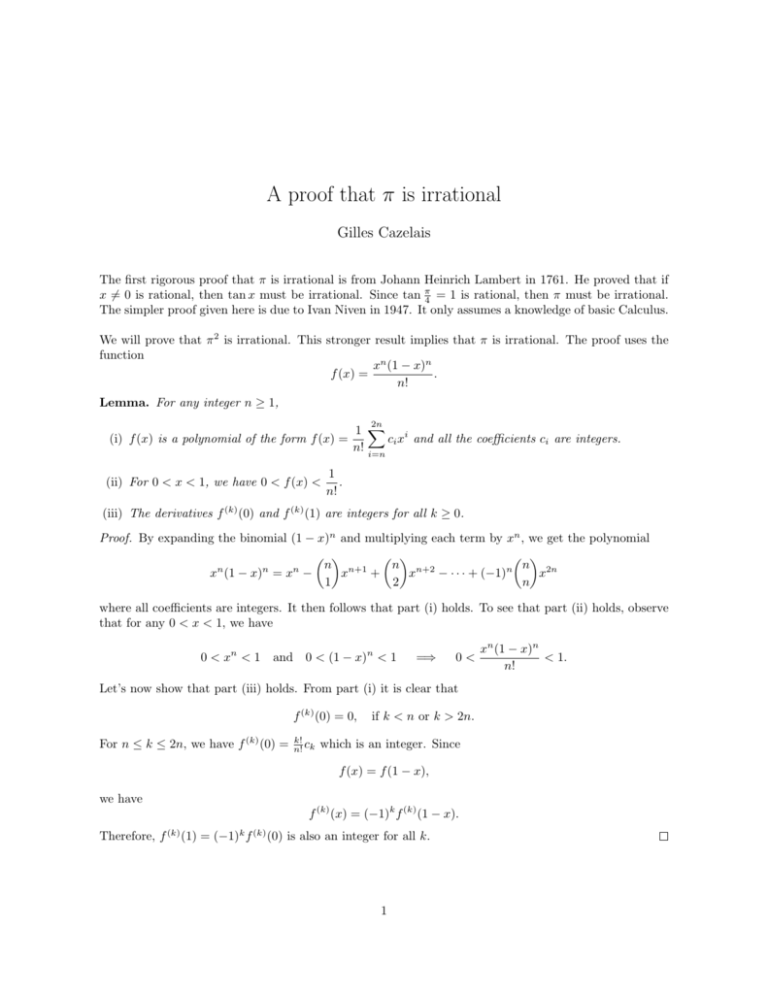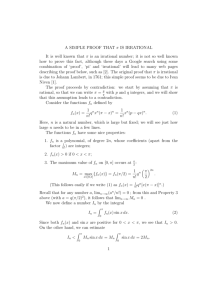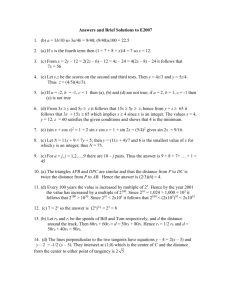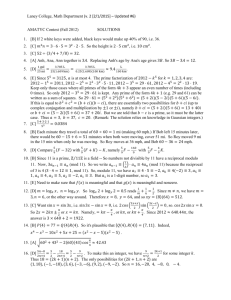A proof that π is irrational
advertisement

A proof that π is irrational Gilles Cazelais The first rigorous proof that π is irrational is from Johann Heinrich Lambert in 1761. He proved that if x 6= 0 is rational, then tan x must be irrational. Since tan π4 = 1 is rational, then π must be irrational. The simpler proof given here is due to Ivan Niven in 1947. It only assumes a knowledge of basic Calculus. We will prove that π 2 is irrational. This stronger result implies that π is irrational. The proof uses the function xn (1 − x)n f (x) = . n! Lemma. For any integer n ≥ 1, 2n (i) f (x) is a polynomial of the form f (x) = (ii) For 0 < x < 1, we have 0 < f (x) < 1 X ci xi and all the coefficients ci are integers. n! i=n 1 . n! (iii) The derivatives f (k) (0) and f (k) (1) are integers for all k ≥ 0. Proof. By expanding the binomial (1 − x)n and multiplying each term by xn , we get the polynomial n n+1 n n+2 n n n n n x (1 − x) = x − x + x − · · · + (−1) x2n 1 2 n where all coefficients are integers. It then follows that part (i) holds. To see that part (ii) holds, observe that for any 0 < x < 1, we have 0 < xn < 1 and 0 < (1 − x)n < 1 =⇒ 0< Let’s now show that part (iii) holds. From part (i) it is clear that f (k) (0) = 0, For n ≤ k ≤ 2n, we have f (k) (0) = k! n! ck if k < n or k > 2n. which is an integer. Since f (x) = f (1 − x), we have f (k) (x) = (−1)k f (k) (1 − x). Therefore, f (k) (1) = (−1)k f (k) (0) is also an integer for all k. 1 xn (1 − x)n < 1. n! Theorem. π 2 is irrational. Proof. Assume that π 2 is rational, i.e., π 2 = a/b for two positive integers a and b. Let F (x) = bn π 2n f (x) − π 2n−2 f (2) (x) + π 2n−4 f (4) (x) − · · · + (−1)n f (2n) (x) . (1) Observe that for all 0 ≤ k ≤ n, bn π 2n−2k = bn (π 2 )n−k = bn a n−k b = an−k bk is an integer. Since f (k) (0) and f (k) (1) are integers, we see that F (0) and F (1) are integers. Differentiating F twice gives (2) F 00 (x) = bn π 2n f (2) (x) − π 2n−2 f (4) (x) + π 2n−4 f (6) (x) − · · · + (−1)n f (2n+2) (x) . Observe that f (2n+2) (x) = 0. From (1) and (2), we get F 00 (x) + π 2 F (x) = bn π 2n+2 f (x) = π 2 an f (x). By differentiation, we get d 0 (((( 0 (((( πF( (x) cos πx + π 2 F (x) sin πx πF( (x) cos πx + F 00 (x) sin πx − ( (F 0 (x) sin πx − πF (x) cos πx) = ( dx = F 00 (x) + π 2 F (x) sin πx = π 2 an f (x) sin πx, from (3). From the Fundamental Theorem of Calculus, we get Z 1 1 π 2 an f (x) sin πx dx = (F 0 (x) sin πx − πF (x) cos πx) 0 0 = F 0 (1) sin π − πF (1) cos π − F 0 (0) sin 0 + πF (0) cos 0 = π (F (1) + F (0)) . Thus, πan Z 1 f (x) sin πx dx = F (1) + F (0) 0 is an integer. Since 0 < f (x) < 1/n! for 0 < x < 1, then 0 < f (x) sin πx < 1 , n! for 0 < x < 1. Therefore, for any integer n ≥ 1 we have n Z 0 < πa 1 f (x) sin πx dx < 0 πan . n! Since for any number a, we have an =0 n→∞ n! n we can choose n large enough so that πa n! < 1. This gives us Z 1 0 < πan f (x) sin πx dx < 1 lim 0 R1 which is a contradiction since πan 0 f (x) sin πx dx is an integer. Therefore π 2 is irrational. 2 (3)







